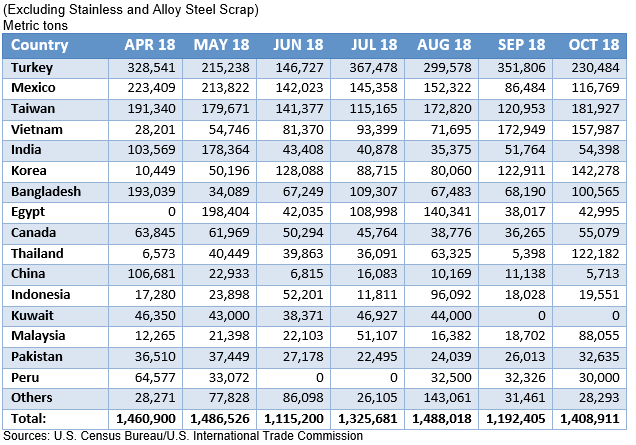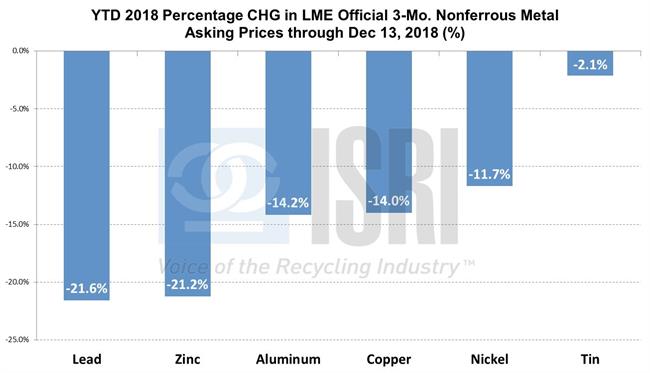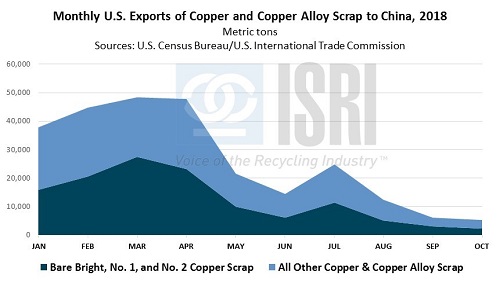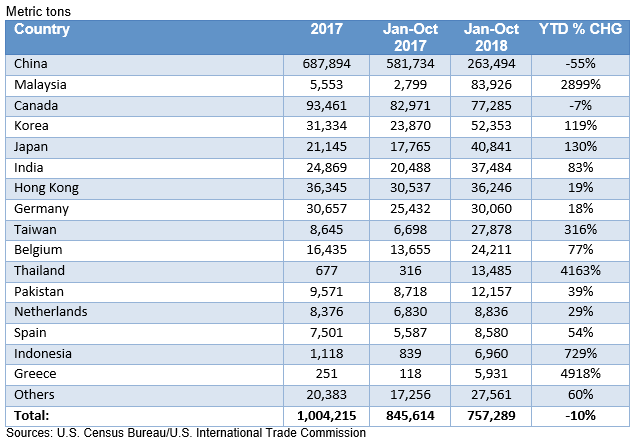Ferrous – Last week, Scrap Price Bulletin was listing U.S. composite ferrous scrap prices for No. 1 HMS at $335.17/gt (+13% Y-o-Y), shredded at $362.17/gt (+16% Y-o-Y), and No. 1 Dealer Bundles at $392.17/gt (+13% Y-o-Y). Fastmarkets SPB notes, “North America’s ferrous scrap market settled in a two-tier direction in December, with the Coasts down $10 to $20, the Midwest and South generally sideways, and Canada up slightly.”
Unsteady export demand was cited as a source of price weakness along the coasts. AMM reported last week that “Turkish steel mills continued to stay out of the deep-sea scrap markets on Thursday December 13 and are unlikely to resume buying any time soon due to the continuing lack of demand for finished steel in the country's domestic and export markets.”
For the year to date (through October), Turkish demand for U.S. ferrous scrap was up 2% as compared to the first 10 months of 2017 to more than 2.9 million metric tons, according to Commerce Dept. trade data. But the data also show a slowdown in shipments to Turkey in October to just over 230,000 mt, down from more that 350,000 mt shipped in September.. However, improved trade flows with Thailand, Malaysia, Mexico, Taiwan, South Korea, and Bangladesh, among other, more than offset the October downturn in Turkish demand. For the Jan-Oct 2018 period, the official trade figures show U.S. exports of ferrous scrap (ex-stainless and alloy steel scrap) were up 20% year-on-year to nearly 13.4 million metric tons.
Monthly Trend in U.S. Ferrous Scrap Exports to Major Destinations

Nonferrous – Through December 13th, prices for the major nonferrous metal at the London Metal Exchange were all in negative territory as compared to the end of last year. Lead prices have been the worst performer this year (-21.6%) while tin prices have held up relatively (-2.1%) well.

The average LME 3-mo. asking price for copper was down 14% through December 13th, while AMM continues to report divergence between spreads for different grades of copper and copper alloy scrap: “Copper and brass scrap markets in the United States were mixed this week, with fading domestic demand weighing on some copper scrap discounts while firm overseas demand helped to hold other prices steady.” While Chinese demand for higher quality copper & alloy scrap grades has held up relatively better than for other commodities, the trend overall has been painful:

While copper and copper alloy scrap shipments to China are down 55% by volume so far this year, gains to Malaysia, South Korea, Japan, India, Thailand, and others helped to offset the reduction in shipments to mainland China. Of note, there is a nice new
tool from the U.S. International Trade Administration to help exporters determine what new markets they might want to look at developing. It’s super easy to use, just enter in the 6 digit HS code, what country you’re currently doing business with, and zip code, and it comes back with top markets to look at, how much of that product those countries are buying, and what the tariff levels are. It also provides info about the US market share, import growth, import costs, and other factors. ITA will have a
webinar on how to use the tool next Tuesday the 18
th at 10 am.
Monthly Trend in U.S. Copper and Cu Alloy Scrap Exports to Major Destinations

Paper and Plastic – China’s demand for U.S. recovered paper reportedly dropped sharply in November. RISI reports that west coast exports for DSOCC-12 declined by $50 per short ton. Chinese demand for recovered paper tends to drop the closer we get to the Lunar New Year. While processors may rightly consider this unusual, the new trade policies have already changed consumption patterns and a relatively significant increase in OCC exports during the late summer months into the fall was also a departure from usual consumption demand from China.
Food packaging is continuing to make forays into the recycling stream. The Paper Stock Report recently posted that Tetra Pak and Veolia are in a partnership to enable the recycling of their beverage cartons in European recycling programs by 2025. This may be prompting other adaptations such as Georgia-Pacific’s intention to add sorting capacity to their containerboard mill in Toledo, OR. However, the focus for such an addition would be to source from commercial sources rather than transfer from residential curbside programs.
Japan’s state minister of the environment announced that Japan needs to move away from waste-to-energy. Plastic scrap volumes have been increasing beyond their capacity to mechanically process or landfill. This may be a difficult pill to swallow for Japan as their domestic sources for energy are rather limited. The glut of fossil fuels from the U.S., Russia, and Saudi Arabia is unlikely to help keep feedstocks down and consumer demands appear to be shifting towards more film consumption as alternatives for other plastic products are being adopted.
For more information, please contact ReMA Research Analyst Bernie Lee.